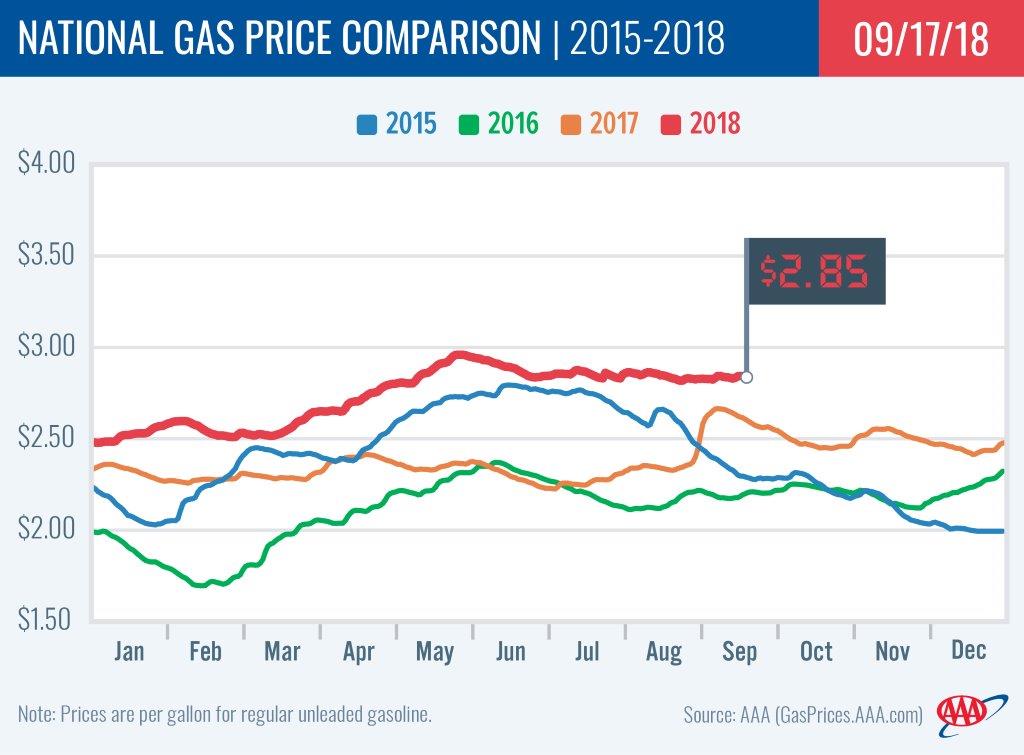PORTLAND, Ore., – While Hurricane Florence battered the Carolinas over the weekend with life-threating storm-surge, rain and flooding, it has had little to no impact on gas prices. For the week, the national average for regular ticks up half a cent to $2.85 while Oregon’s average dips half a cent to $3.25.
Gas prices have not seen much movement because unlike the Gulf Coast, which is home to dozens of refineries, the Carolinas house only pipelines and terminals. This means U.S. crude processing is not impacted and therefore neither are gas prices. However, delivery of gasoline in the storm-impacted areas is another story. Flooding, washed out roads and power outages may impede fuel deliveries. While fuel availability is a concern, AAA expects station outages and price spikes to be short-lived. According to the U.S. Department of Energy, states are working closely with industry to expedite resupply shipments to impacted areas.
In other parts of the country, gas prices are edging lower due to the switchover to winter-blend gasoline which begins every year on September 15. This fuel is less expensive to produce than the more environmentally-friendly summer-blend fuel.
Oregon is one of 20 states and the District of Colombia where prices have decreased week-over-week. Delaware has the largest weekly decrease (-3 cents). Iowa has the largest weekly increase (+5 cents). Weekly price changes are minimal in most states; Oregon is one of 40 states and D.C. where prices went up or down by two cents or less week-over-week. This week 10 states have averages at or above $3 a gallon, same as a week ago.
Oregon and Hawaii are the two states where prices now are exactly the same as one month ago. Prices increased in 20 states and decreased in 28 states and the District of Columbia. The national average is fractions of a cent more than a month ago. Indiana (-6 cents) has the largest monthly decrease, while Colorado (+12 cents) has the largest monthly increase.
The West Coast continues to have the most expensive gas prices in the nation. Hawaii tops the list for the 15th week in a row with California, Washington, Alaska, Oregon and Idaho and Nevada rounding out the top seven. Oregon is fifth for the third week in a row. Prices in the region are mostly flat compared to last week.
| Rank | Region | Price on 9/18/18 | |
| 1 | Hawaii | $3.78 | |
| 2 | California | $3.64 | |
| 3 | Washington | $3.39 | |
| 4 | Alaska | $3.32 | |
| 5 | Oregon | $3.25 | |
| 6 | Idaho | $3.21 | |
| 7 | Nevada | $3.20 | |
| 8 | Utah | $3.13 | |
| 9 | Pennsylvania | $3.07 | |
| 10 | Connecticut | $3.04 |
The U.S. Energy Information Administration’s weekly petroleum status report shows West Coast motor gasoline stocks at 28.4 million bbl during the week that ended on September 7 – a gain of 100,000 bbl from the previous week. Stocks are 1.3 million bbl lower than where they were at this time last year, which could support a price spike if supplies remain low amid an increase in demand and/or refinery outages.
The nation’s cheapest markets are Alabama ($2.52) and Mississippi ($2.54). For the 59th week in a row, no states have an average below $2.
Drivers in all 50 states and the District of Columbia are paying more than a year ago to fill up. The national average is 22 cents more and the Oregon average is 35 cents more than a year ago. This is the 13th-largest yearly increase in the country. Hawaii (+66 cents) has the greatest year-over-year increase; California (+48 cents) is second; Utah (+48 cents) is third; Arizona (+44 cents) is fourth; and Idaho (+43 cents) is fifth.
Oil Market Dynamics
Crude oil prices have risen in the last week following the release of the EIA’s weekly petroleum report that showed crude stocks fell by 5.3 million bbl last week. If supplies fall again in this week’s report, crude prices could climb further. Dwindling supplies have put a spotlight on shrinking global crude inventories, which could cause oil prices to push to $70 to $80/bbl this fall.
Continued decline in crude production from Venezuela and anticipated reduced crude exports from Iran due to U.S.-imposed sanctions that go into effect in November could place greater pressure on the market. In the near term, U.S. crude production has not been impacted by Hurricane Florence, as there were no refineries in the storm’s path.
At the close of Friday’s formal trading session on the NYMEX, WTI increased 40 cents to settle at $68.99. At the close of Monday’s formal trading session on the NYMEX, WTI dropped 8 cents to settle at $68.91. Today crude is trading around $70, compared to $69 a week ago. Crude prices are up about four percent in the last month and are about $19 more per barrel than a year ago.
Drivers can find current gas prices along their route with the free AAA Mobile app for iPhone, iPad and Android. The app can also be used to map a route, find discounts, book a hotel and access AAA roadside assistance. Learn more at AAA.com/mobile.
Diesel
For the week, the national average remains at $3.18 a gallon. Oregon’s average slips a penny to $3.38. A year ago the national average for diesel was $2.72 and the Oregon average was $2.94.
Find current fuel prices at GasPrices.AAA.com.
AAA news releases, high resolution images, broadcast-quality video, fact sheets and podcasts are available on the AAA NewsRoom at NewsRoom.AAA.com.



